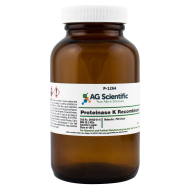Protein Proteolysis refers to the use of hydrochloric acid to destroy peptide bonds between the amino acids that make up a protein. When carried out with proteases (also known as proteinases), which are enzymes, the process is termed proteolysis. Depending on how efficient the enzyme is or what links it breaks, the proteolysis can be limited or unlimited. Proteolysis can begin either from one end of the chain of amino acids that comprise the protein or somewhere in the middle of it. Unlimited proteolysis produces individual amino acids while limited proteolysis produces short chains of polypeptides.
Proteases are currently classified into six broad groups:
-
Serine proteases
- Threonine proteases
- Cysteine proteases
- Aspartate proteases
- Metalloproteases
- Glutamic acid proteases
Instructions for using Protease for Protein Proteolysis
1. Dissolve 1 mg of target protein in 20 mL of the appropriate enzyme buffer: The exact quantity will determine the type of gel staining required later. In general, microgram quantities of protein will require nanogram quantities of protease enzyme but several hours of reaction, and analysis via silver staining. On the other hand, larger amounts of protein will require microgram levels of enzyme but only minutes to react and therefore a Coomassie stain is used to visualize the sizes of the resulting peptides. The ratio of protease-to-protein in a reaction should be 1:1000.
2. Add 1 mL of each protease to the solution of protein to be digested (See Calyculin A inhibitor) Since proteins are made up of many different peptides and therefore many different peptide links, more than one protease may be needed, either sequentially, or in combination as long as they do not destroy each other. Commonly used enzymes include proteinase K, trypsin, papain, elastase and chymotrypsin, and a cocktail of several of these can be used to tackle the many types of links present in any given protein. Note that the buffer needed for the reaction will depend on what enzyme(s) are used.
3. Carry out the reaction at 98.6°F for 90 minutes. Because different enzymes will have different efficiencies and reaction requirements (including but not limited to temperature and buffer composition), it is necessary to determine the optimal reaction volume and duration for complete hydrolysis. Some enzymes achieve complete hydrolysis when long reactions are carried out (i.e. Proteolysis is unlimited), hence it is important for the user to decide before starting if it is the individual amino acid or polypeptide that is required. Reaction times can start and increase in 10 minute increments up to 60 minutes at first, and if analysis shows that insufficient amino acids or polypeptides are detected, then this can be increased up to 3 hours.
4. Electrophoretically size-separate the reaction products on a polyacrylamide gel and stain this with either silver or Coomassie to allow visualisation of the digested peptides or amino acids.

